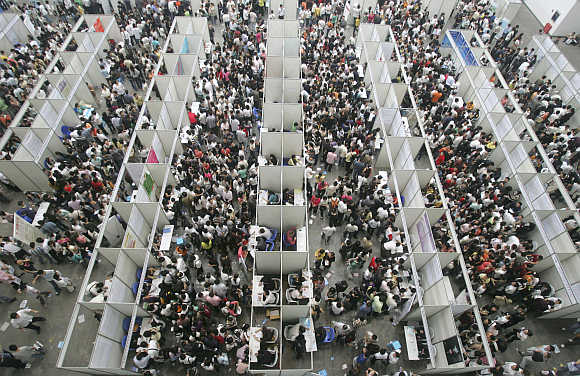 | « Back to article | Print this article |
As growth loses steam, unemployment up 10% in 2 years
In what could lend ammunition to those criticising the government’s so-called jobless growth model, unemployment in India had risen 10.2 per cent in two years, official data showed on Thursday.
Compared with 9.8 million on January 1, 2010, 10.8 million people were without any job on January 1, 2012.
Some analysts said, the rise in unemployment was the reflection of a sharp drop in the rate of GDP growth, which plunged to 6.2 per cent in 2011-12 and further to a decade low of five per cent in 2012-13.
Click NEXT to read further. . .
As growth loses steam, unemployment up 10% in 2 years
The data were part of a report released by the National Sample Survey Organisation in New Delhi.
However, analysts said, the unemployment data were collated on the basis of a person’s primary area of activity, as well as his other optional works.
So, the number of jobless people could be higher if only the prime activity was taken into account.
This argument is clear from the report. It shows the unemployment rate rose 0.2 percentage points to 2.7 per cent in 2011-12 (July-June), against 2.5 per cent in 2009-10.
Click NEXT to read further. . .
As growth loses steam, unemployment up 10% in 2 years
The data are based on principal activity that people were engaged in during the period.
However, if their other activities are included, the unemployment rate stands at 2.2 per cent, compared with two per cent in the same period.
Here, too, the rise is of 0.2 percentage points.
But the unemployment rate has fallen to 2.2 per cent during 2011-12, against 2.7 per cent if only primary activity is taken into account.
National Statistical Commission Chairman Pronab Sen said deceleration in growth had led to a rise in unemployment, but it was not huge.
Click NEXT to read further. . .
As growth loses steam, unemployment up 10% in 2 years
Unemployment rises across genders
For the two years ended June 30, 2012, unemployment rose across genders.
In aggregate terms, it rose 0.2 percentage points during the period. Unemployment for women was higher than that for men, according to data released in the 68th round of the National Sample Survey.
If primary work alone is taken into account, unemployment for women rose 0.4 percentage points to 37 per 1,000 people willing to work (3.7 per cent) in 2011-12, against 33 per 1,000 in 2009-10.
In the case of men, unemployment rose 0.2 percentage points to 2.4 per cent, against 2.2 per cent in 2009-10. During the period, overall unemployment rose from 2.5 per cent to 2.7 per cent.
Click NEXT to read further. . .
As growth loses steam, unemployment up 10% in 2 years
However, if the work under other schemes (for instance, work under the Mahatma Gandhi National Rural Employment Guarantee Scheme) is also considered, the rise in overall unemployment works out to 0.1 percentage points.
For men, unemployment rose from two per cent to 2.1 per cent, while for women, it rose from 2.3 per cent to 2.4 per cent.
Unemployment in urban areas, for both men and women, was higher than in rural areas.
In rural areas, unemployment rose from 2.1 per cent in 2009-10 to 2.4 per cent in 2011-12, if primary work alone is considered; in urban areas, it rose from 3.7 per cent to 3.8 per cent.
Click NEXT to read further. . .
As growth loses steam, unemployment up 10% in 2 years
If other work is also taken into account, the rise in unemployment in rural areas works out to 1.7 per cent, against 1.6 per cent in 2009-10. For urban areas, it remained flat at 3.4 per cent.
Between 2004-05 and 2009-10 (a period roughly coinciding with the first term of the United Progressive Alliance government), unemployment had declined.
However, according to the 12th Plan document, unemployment in the manufacturing sector rose by five million during this period. National Statistical Commission Chairman and former chief statistician Pronab Sen said between 2009-10 and 2011-12, layoffs hadn’t been reported.
However, the job market might not be recording employment in sufficient numbers, he added.






